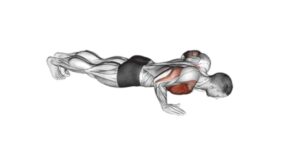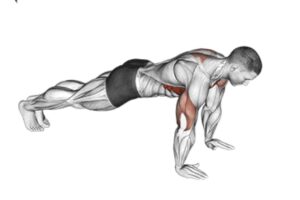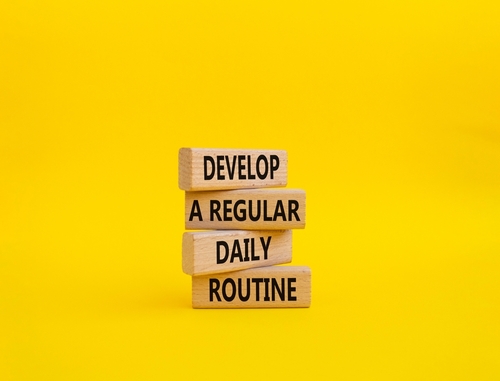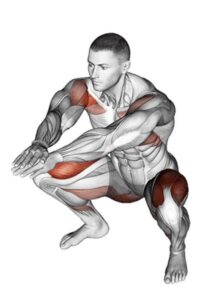Incorporating a regular exercise routine into your daily life can have numerous benefits for your overall health and well-being. A frequent discussion in our office is what that regular exercise routine should look like. Although the answer to this question is certainly best answered when one knows the present health conditions and the goals of the patient, there are some overall principles that can be taken from this article and scaled to meet your specific situation. The most common answer that I give to this question is to perform 100 push-ups, 50 squats, and to run 1 mile every day. Read on to find out the benefits of this exercise prescription.
100 Push-ups

 Doing 100 pushups per day can offer several benefits for your physical fitness and overall health. Here are some potential advantages:
Doing 100 pushups per day can offer several benefits for your physical fitness and overall health. Here are some potential advantages:
- Strength and Muscle Development: Pushups primarily target the muscles in your chest, shoulders, triceps, and core. Regularly performing 100 pushups can help build upper body strength and toned muscles.
- Increased Endurance: Pushups engage multiple muscle groups simultaneously, requiring both strength and endurance. By consistently performing 100 pushups per day, you can enhance your muscular endurance, allowing you to perform other physical activities for longer durations without fatigue.
- Core Stability: Pushups engage your core muscles, including the abs and lower back, as stabilizers. As you maintain proper form during pushups, you’ll strengthen your core, leading to improved stability, balance, and overall posture.
- Convenience and Accessibility: Pushups require no special equipment and can be done virtually anywhere. By incorporating them into your daily routine, you have a convenient way to work out and maintain your fitness without relying on a gym or specific equipment.
- Time Efficiency: Completing 100 pushups doesn’t take a significant amount of time compared to other workouts. It can be an efficient way to engage multiple muscle groups and get your heart rate up, especially if you have limited time for exercise.
- Enhanced Metabolic Rate: Engaging in intense exercise, like doing 100 pushups, can elevate your heart rate and stimulate your metabolism. This can potentially lead to increased calorie burn during and after your workout, contributing to weight management.
- Superior Exercise: While both pushups and bench press exercises target similar muscle groups, they have some differences that may make pushups more advantageous. The number one reason to choose push-ups over bench press is the functional strength that push-ups create. They engage multiple muscle groups and require coordination and balance, contributing to overall functional strength. Bench press exercises, while effective for building upper body strength, focus more on isolating specific muscle groups. In bench press exercises, there’s a tendency to overemphasize certain muscle groups, potentially leading to imbalances if not properly addressed.
Doing 50 squats per day can be an effective form of exercise that specifically targets several muscle groups and offers various benefits.
- Strengthens lower body muscles: Squats primarily engage your quadriceps, hamstrings, and glutes, but they also activate your calves and core muscles to a certain extent. Regularly performing squats can help strengthen these muscles, leading to improved overall lower body strength and stability.
- Enhances functional fitness: Squats mimic the natural movements involved in activities like sitting down, standing up, or lifting objects from the ground. By strengthening the muscles involved in these movements, you can improve your overall functional fitness and make daily tasks easier to perform.
- Boosts calorie burning: Squats are a compound exercise that engages large muscle groups, requiring significant energy expenditure. Performing 50 squats per day can contribute to increased calorie burning, which may support weight management or weight loss goals when combined with a balanced diet.
- Improves flexibility and range of motion: Squats require a good range of motion in your lower body joints. Regularly performing squats can improve flexibility and help maintain or increase your range of motion in your hips, knees, and ankles.
- Enhances posture and balance: Squats engage your core muscles and encourage proper posture. By regularly practicing squats, you can improve your posture and balance, leading to a more aligned and stable body.
Proper squat form is crucial to maximize the benefits of the exercise and minimize the risk of injury. Here’s a step-by-step guide to performing a squat with proper form:
Starting position: Stand with your feet shoulder-width apart or slightly wider. Toes should be pointed slightly outward, about 5 to 20 degrees. Keep your chest up and your gaze forward. Maintain a neutral spine throughout the movement, avoiding excessive rounding or arching of the back.
Descending phase: Initiate the movement by bending your knees and hips simultaneously. Imagine sitting back into an imaginary chair. Lower your body down as if you’re trying to get your thighs parallel to the ground or slightly below. Ensure that your knees are tracking in line with your toes as you descend, avoiding excessive inward or outward movement. This helps maintain proper alignment and reduces strain on the knee joints. Aim to lower yourself to a comfortable depth while maintaining proper form. Your range of motion may vary depending on your flexibility and strength. It’s important not to compromise form for depth. Gradually increase your depth over time as you become more comfortable and flexible.
Ascending phase: Push through your heels and midfoot as you begin to stand back up. Extend your hips and knees simultaneously to return to the starting position. Focus on driving upward with control and maintaining stability. Make sure to inhale as you lower your body down, and exhale as you push through the upward phase of the squat.
Running one mile can offer several benefits for your physical and mental well-being. Here are some of the benefits:
- Cardiovascular Health: Running helps improve your heart health by increasing your heart rate, strengthening your heart muscles, and improving blood circulation. Regular running can reduce the risk of cardiovascular diseases such as heart attacks, strokes, and high blood pressure.
- Weight Management: Running is an effective exercise for burning calories and maintaining a healthy weight. Running one mile can help you burn approximately 100-150 calories, depending on factors such as your weight and running speed. Regular running can contribute to weight loss or weight maintenance when combined with a balanced diet.
- Bone and Joint Health: Running is a weight-bearing exercise that puts stress on your bones, helping to improve bone density and prevent conditions like osteoporosis. It also strengthens the muscles around your joints, which can reduce the risk of joint-related problems like arthritis.
- Mental Well-being: Running releases endorphins, also known as “feel-good” hormones, which can boost your mood, reduce stress, and alleviate symptoms of anxiety and depression. It can also enhance your overall mental well-being, increase self-confidence, and improve cognitive function.
- Increased Energy Levels: Regular running can improve your stamina and overall energy levels. As you become fitter and more accustomed to running, you may notice increased energy throughout the day and improved productivity.
- Improved Sleep: Running can contribute to better sleep quality. Physical activity, including running, can help regulate your sleep patterns, promote deeper sleep, and reduce insomnia symptoms.
- Stronger Immune System: Moderate exercise like running can enhance your immune system’s function, reducing the risk of minor illnesses such as colds and flu.
- Social Interaction: Running can be a social activity, allowing you to connect with other runners through group runs, races, or running clubs. This social aspect can provide a sense of community and motivation, making your running experience more enjoyable.
A question that naturally comes from this recommendation is “Why only one mile and not more?” The main reason for this is time efficiency. If you have limited time available or are new to running, running one mile can be a quick and achievable goal. Likewise, you can be more consistent with the lesser time commitment of running only one mile which is much more important than any gains achieved from running longer distances.










